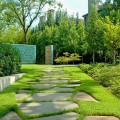Architecture Landscape: Modern Times, Modern Methods
Architecture landscape uses time-honored principles of design to create stunning and livable landscapes. The components of such a modern, inspired landscape include:
- Working with nature. Taking the biological and geographical factors of your property and letting them determine the design and the impact of man-made enhancements.
- Enrichment through diversity. Planning and designing microenvironments to create stability.
- Landscapes as a process. Creating designs that grow over time and evolve naturally—but aesthetically.
- Creativity. Using both the property owners’ desires and the limitations and possibilities of the site as the design catalyst.
- Minimal energy consumption. Employing local materials in the design process to decrease maintenance costs.
- Return on investment. Using the landscape to increase property value and, equally important, homeowner pleasure and enjoyment.
In the design process, architecture landscape considers the use of garden themes, including natural landscapes and formal landscapes; architectural structures, such as entrances and art sculptures; living spaces—patios, outdoor living rooms, and outdoor kitchens; critical areas—security, such as fences, gates, driveways and walkways; waterscapes, including fountains, pools and spas.
Thoughtful architecture landscape can be used to solve many problems being dealt with in this 21st century. For example, many parents are concerned about their children being captivated by YouTube, Xbox, and the App Store. However, well-designed backyard playgrounds can entice kids to step away from the screens for some outdoor play time. These playground designers create playgrounds that challenge kids to go higher and engage new muscles. These places are not only fun, but can be artful and visually pleasing—a space that is sure to become a favorite family gathering place.
While “sustainability” and “green” ideology are the current buzzwords of the architecture landscape world—and it doesn’t take much perusing of the media and websites of this community to get excited about what’s going on—public opinion and actual application are slow to change. It will most likely be decades before acceptance is universal. But perhaps it makes sense to shine the light on the most practical aspects of sustainability: saving money. When that is the focus, things like planting design, maintenance requirements, soil health, water usage and resource consumption often fall in line.
So, let’s talk about lawn care. The recent drought years in Texas has put an urgent focus on the water requirements for landscape and lawn use. Additionally, the use of fertilizers and pesticides, electricity or gas to mow, and labor to care for lawns are also common issues. Architecture landscape could help you find some really attractive alternatives.
Another issue Houston homeowners face is stormwater management. Here rain gardens are becoming more prevalent in design, incorporating aquatic plants into attractive and practical designs. By using native plants that are used to our climate and soil, you can add texture, color and distinct forms to your yards.
In the end, everyone must find their own balance of ecology and design. But believe it or not, we truly can change the world by changing our world.

